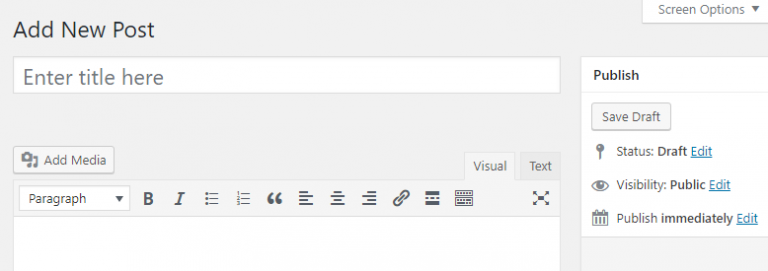3 Ways to Prepare Before Launching Your New Blog
- Category : Development
- Posted on : Jul 13, 2017
- Views : 2,470
- By : Kapueo I.

Many people get an idea for a fantastic blog, and launch into the project without much thought. While enthusiasm is important, there are some things to consider before you start work on your new blog if you want to hit the ground running.
There are plenty of steps involved in launching a website. You’ll need to figure out what pages to include, decide where your blog should be hosted, and get a head start on producing content. The more time you take to prepare, the more likely it is that your blog’s launch will go off without a hitch.
In this article, we’re going to discuss three key tasks you should perform before creating a new blog. We’ll break down why each is important, and talk about how to get your blog ready for its launch. Let’s get to work!
1. Create a Diagram of Your Website’s Layout
Take a look at the page you’re currently reading. It consists of a header section that includes two menus and a logo. The body of the article is located next to a search bar, a sidebar, a related posts section, and social media links. Finally, there’s a comments section and a footer below the article.
This may seem like a lot of disparate parts. When you see the site in action, however, all its components work together smoothly. When you build your own website, one of the things that can slow you the most is creating its layout. You’ll need to carefully consider how the site should be structured, and decide which elements you want to include on each page.
One method of making this process easier is to create a rough diagram of what you want your website to look like when it’s done. Your diagram doesn’t need to be a work of art; it just has to serve as a guideline you can use when building your website. To get started, grab few pieces of paper and a pencil, and follow these instructions:
- Make a simple list of all the pages you want your website to include.
- Start with your homepage’s header, think about what elements it will need (for example, a logo and a menu), and sketch their placement.
- Then, consider the body of your home page and how you want it to look. Decide if you want to include sidebars or make the page full-width, and sketch out where each individual element should go.
- Wrap things up by considering your footer and what you want it to contain, such as important links, copyright information, and contact details. Once again, you’ll want to determine exactly where each section or piece of information should be located.
It’s a smart idea to create a diagram like this for each page you’ll be adding to your blog. Some elements should remain consistent across all pages, however, such as your header and footer. When you’re done, you’ll have a clear idea of what you want your website to look like and what elements it will include. This is a simple process, and it will save you a lot of time in the long run.
2. Get a Head Start on Creating Content

Getting the inspiration you need to write quality content can be difficult, even when you have a blog up and running. Your first couple of posts can be particularly intimidating, especially if you’re not used to publishing content online.
The best way to deal with this is to get a head start on your content before your blog launches. If you have multiple blog posts ready by the time you cut the ribbon, your launch will go a lot smoother. Visitors will have some content to enjoy right away, and you can establish a consistent posting schedule. Additionally, if this is your first time creating a website, you might run into unexpected technical issues. If that’s the case, you’ll be glad you have some articles ready to go while you focus on troubleshooting.
You probably already have an idea for what you’ll write about on your new blog. You can build on that to create your first few articles. Here are some steps you can take to get started:
- Compile a list of potential topic ideas based on your blog’s niche.
- Create outlines for those ideas, so you have a rough idea of what each post will contain.
- Sit down and write, until you have at least two or three posts ready to go.
You should also consider how often you plan on publishing content once your blog goes live. In our experience, one post per week is an ideal frequency when you’re just starting out. Pick a day and time to publish your content each week, and stick with it. Consistency is the key to attracting return visitors.
3. Pick a Domain Name and Choose a Hosting Plan
Once you have the layout of your site and some content ready, it’s time to take care of a few more technical tasks. The first thing you’ll need to do is pick a domain name and register it.
You’ll want to opt for something short and easy to remember, but also unique and clearly connected to your blog’s topic. For more advice, you can check out our previous post on choosing the perfect domain name.
Next, you’ll need to pick a hosting plan for your website. In most cases, you’ll want to start off with shared hosting, since it’s a low-cost option and is more than powerful enough for a starter blog.
If you’ve never chosen a hosting plan before, you’ll notice that you have a broad range of options. Naturally, the more expensive plans will provide you with better performance and more features. However, there’s no need to spend a considerable amount of money on your site right away.
Instead, focus on finding a quality hosting provider, sign up for their starter plan, and get to work on building your website. You can always upgrade your plan at any time, so the smart approach is to wait until you need the extra power and then consider your options.
Conclusion
The more prepared you are, the better your results will be. This maxim applies to all aspects of life, including running a blog. These days, creating a blog is easier than ever. However, you should still take some time to plan out your approach and gather everything you’ll need before taking the plunge.
If you’re thinking about launching a new blog, here are three ways to put your best foot forward:
- Create a diagram of your website’s layout.
- Get a head start on creating content.
- Pick a domain name and choose a low-cost hosting plan.
Do you have any questions about how to prepare for your new blog’s launch? Let’s talk about them in the comments section below!
Categories
- cPanel Question 47
- cPanel Software Management 29
- cPanel Tutorials 13
- Development 29
- Domain 13
- General 19
- Linux Helpline (Easy Guide) 156
- Marketing 47
- MySQL Question 13
- News 2
- PHP Configuration 14
- SEO 4
- SEO 42
- Server Administration 84
- SSL Installation 54
- Tips and Tricks 24
- VPS 3
- Web Hosting 44
- Website Security 22
- WHM questions 13
- WordPress 148
Subscribe Now
10,000 successful online businessmen like to have our content directly delivered to their inbox. Subscribe to our newsletter!Archive Calendar
| Sat | Sun | Mon | Tue | Wed | Thu | Fri |
|---|---|---|---|---|---|---|
| 1 | 2 | 3 | 4 | |||
| 5 | 6 | 7 | 8 | 9 | 10 | 11 |
| 12 | 13 | 14 | 15 | 16 | 17 | 18 |
| 19 | 20 | 21 | 22 | 23 | 24 | 25 |
| 26 | 27 | 28 | 29 | 30 | 31 | |
Recent Articles
-

Posted on : Sep 17
-

Posted on : Sep 10
-

Posted on : Aug 04
-

Posted on : Apr 01
Tags
- ts
- myisam
- vpn
- sql
- process
- kill
- tweak
- server load
- attack
- ddos mitigation
- Knowledge
- layer 7
- ddos
- webmail
- DMARC
- Development
- nginx
- seo vpn
- Hosting Security
- wireguard
- innodb
- exim
- smtp relay
- smtp
- VPS Hosting
- cpulimit
- Plesk
- Comparison
- cpu
- encryption
- WHM
- xampp
- sysstat
- optimize
- cheap vpn
- php-fpm
- mariadb
- apache
- Small Business
- Error
- Networking
- VPS
- SSD Hosting
- Link Building
- centos
- DNS
- optimization
- ubuntu







